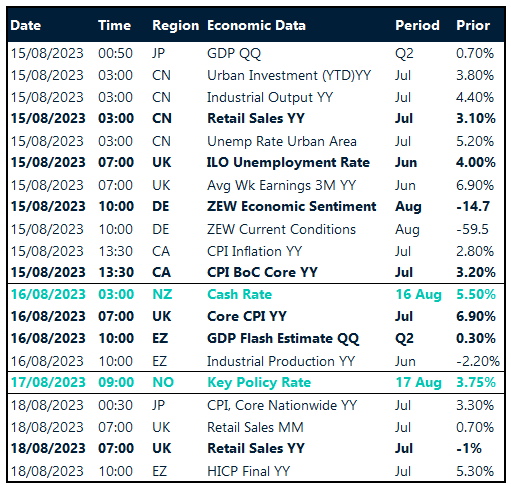UK wage growth hits record high
The pound has started Tuesday on a stronger footing after data showed basic UK wages grew 8.2% in the second quarter, a new record pace and adding to the Bank of England’s (BoE) worries about inflation. The flip side is that unemployment continues to rise, climbing to 4.2% in the three months to June.
GBP/USD dropped to its lowest level since late June yesterday, rebounding just above its 100-day moving average which we called out as a downside target. The pound has built on its recovery thanks to strong wage growth increasing fears that UK services inflation will remain sticky, possibly forcing the BoE to raise interest rates higher after 14 back-to-back increases in borrowing costs. Although the positive appeal from rate and yield differentials may be helping sterling now, we remain wary of the longer-term economic drag from rate hikes and the looming housing crisis and credit risks that could weigh on the pound’s attractiveness further down the line. Early tomorrow morning, the latest UK inflation report will be published, which could trigger more volatility in sterling across the board.
Given that GBP/USD has, on average, depreciated by 4% every year since 2014, a gain of 5% in 2023 so far is particularly impressive for sterling. Elsewhere, GBP/EUR continues to flirt with €1.16, but the biggest surprise is GBP/JPY, which continues to stretch beyond the ¥185 threshold up 1.6% in the last seven trading days.

Dollar hits 1-month high
The US dollar continues its strong summer rally, reaching 1-month highs against a basket of currencies and dragging EUR/USD briefly under $1.09. Despite markets pricing in an end to the Federal Reserve’s (Fed) rate-hiking cycle followed by rate cuts in the first half of next year, the surprising resilience of the US economy, high rates and cautious investor sentiment have kept the dollar well supported.
As tightening cycles for major central banks draw to a close, volatility has hit the lowest levels seen so far this year in equities, FX and interest rate markets. Historically, the normal levels of the VIX, the most well-known measure of stock market volatility, are in the low 20s, meaning the S&P 500 will differ from its average growth rate by no more than 20% most of the time. Since the banking turmoil back in March, the VIX index has only traded above 20 for a couple of days. This low volatility environment bodes well for carry trades, whereby investors borrow a low yielding currency like the Japanese yen and invest in a high yielding currency like the US dollar. This has been reflected in the performance of these currencies so far this year with USD/JPY surging to fresh 2023 highs and GBP/JPY to 2015 highs.
Subsequently, yesterday the US dollar peered above its 200-day moving average for the first time since December 2022, but will this be a key resistance level? Is the dollar’s recent rally about to run out of steam? For a continuation of its long-term downtrend after peaking in September last year, we’ll need to see slowing US economic activity and disinflation to pick up speed.

Euro cushioned by China rate cut
Expectations of rate cuts by the European Central Bank have started building for next year. This has primarily been a function of the cyclical downtrend of the global economy with China and Europe at the centre of it. However, China’s central bank unexpectedly cut key policy rates for a second time in three months to shore up the country’s struggling economy.
A spate of disappointing Chinese economic data has been increasing concerns about the global economic outlook. Even this morning, following China’s rate cut, industrial output, retail sales and investment showed unexpected slowdowns. However, the People’s Bank of China’s decision to cut its policy rate came after new bank loans plunged 89% from a month earlier to the lowest since late 2009. Although the stimulus has dragged the yuan to a 9-month low against the US dollar and weaker against the other peers, the euro has found some much-needed support, climbing back above $1.09 against the dollar this morning.
Looking ahead, the focus today will be on ZEW investor expectations for both Germany and the Eurozone. These have been deteriorating for the last few months and are expected to fall a little more, which could weigh on the euro, though the common currency appears to have decoupled from sentiment data in the short term.

Japanese yen falls to fresh multi-year lows
Table: 7-day currency trends and trading ranges

Key global risk events
Calendar: August 14-18

Have a question? [email protected]
*The FX rates published are provided by Convera’s Market Insights team for research purposes only. The rates have a unique source and may not align to any live exchange rates quoted on other sites. They are not an indication of actual buy/sell rates, or a financial offer.



